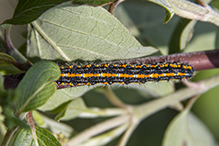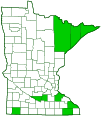Reversed haploa
(Haploa reversa)
Conservation • Description • Habitat • Ecology • Distribution • Taxonomy
| Hodges # | 8109 |
||
Conservation Status |
|||
| IUCN Red List | not listed |
||
| NatureServe | NNR - Unranked SNR - Unranked |
||
| Minnesota | not listed |
||
Description |
Reversed haploa is a broad-winged, somewhat flimsy-looking tiger moth. It occurs in the United States from Ohio to Minnesota south to North Carolina and Oklahoma, and in Ontario. Adults are found from late May to early July in woodlands, wetlands, fields, and gardens. Larvae (caterpillars) feed on the leaves of many woody plants including apple, ash, and elm. Adults are ⅞″ to 1⅛″ (22 to 28 mm) long and have a wingspan of 1¾″ to 2″ (45 to 50 mm). The wings are held over the body like a roof when at rest. The forewing is creamy white with bold, dark brown markings. The inner, outer, and leading (costal) margins are dark except at the wingtip. A long diagonal line extends from the middle of the costal margin to the point where the inner and outer margins meet (anal angle). Before the line, at the wing base, the white area is triangular. Beyond the line the white area is broken into four of five spots. The head is orangish-yellow. The antennae on both the male and female are slender and thread-like. The caterpillar is mostly black with a stripe down the middle (middorsal stripe), one on each upper side (subdorsal stripes), and one on each lower side that passes through the breathing pores (spiracular stripe). The middorsal stripe is mostly red to orange with small yellow or white areas at the margins of the abdominal segments. The subdorsal stripes are orange to yellow or white and are often constricted or broken in the middle of each abdominal segment. The spiracular stripes are mostly broken into a row of spots. Each abdominal segment has six large black warts with a cluster of relatively short, barbed. bristle-like structures (setae). The upper (dorsal) setae are black, those on the sides are whitish. |
Size |
Total length: ⅞″ to 1⅛″ (22 to 28 mm) Wingspan: 1¾″ to 2″ (45 to 50 mm) |
Similar Species |
Habitat |
Woodlands, wetlands, fields, and gardens |
Ecology |
Season |
One generation per year: Late May to early July |
Behavior |
The wings are held over the body like a roof when at rest. |
Life Cycle |
Caterpillars overwinter and pupate in the spring. |
Larva Hosts |
Leaves of woody plants including apple, ash, and elm. |
Adult Food |
|
Distribution |
||
|
Sources 7, 21, 29, 30, 71, 75, 82, 83. Biodiversity occurrence data published by: Minnesota Biodiversity Atlas (accessed through the Minnesota Biodiversity Atlas Portal, bellatlas.umn.edu, 9/1/2025). |
|
| 9/1/2025 | ||
Occurrence |
||
Common |
||
Taxonomy |
|
Order |
Lepidoptera (Butterflies and Moths) |
Superfamily |
Noctuoidea (Owlet Moths and Allies) |
Family |
Erebidae (Underwing, Tiger, Tussock, and Allied Moths) |
Subfamily |
Arctiinae (tiger moths and allies) |
Tribe |
Arctiini (tiger moths) |
| Subtribe | Callimorphina |
Genus |
Haploa |
In 2011 the family Arctiidae (tiger moths and lichen moths) was transferred to the family Erebidae mostly intact but demoted to a subfamily. The former subfamilies are now tribes, the former tribes now subtribes. |
|
Subordinate Taxa |
|
|
|
Synonyms |
|
Callimorpha reversa Callimorpha suffusa |
|
Common Names |
|
reversed haploa reversed haploa moth |
|
Glossary
Anal angle
In insects: The angle at the corner of a wing formed where the outer and inner margins meet.
Costal margin
The leading edge of the forewing of insects.
Seta
A stiff, hair-like process on the outer surface of an organism. In Lepidoptera: A usually rigid bristle- or hair-like outgrowth used to sense touch. In mosses: The stalk supporting a spore-bearing capsule and supplying it with nutrients. Plural: setae. Adjective: setose.
Spiracle
A small opening on the surface of an insect or arachnid through which it breathes.
Visitor Photos |
Share your photo of this insect. |
||
This button not working for you? |
||
|
||
MinnesotaSeasons.com Photos |
 |
 |

Slideshows |
|

Visitor Videos |
Share your video of this insect. |
||
This button not working for you? |
||
|
Other Videos |
|

Visitor Sightings |
Report a sighting of this insect. |
||
This button not working for you? |
||
MinnesotaSeasons.com Sightings |

|
Created: 1/11/2020 Last Updated: © MinnesotaSeasons.com. All rights reserved. |
